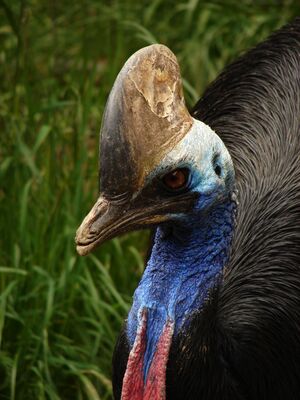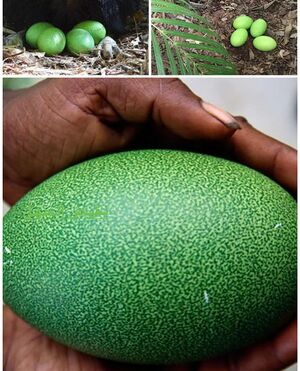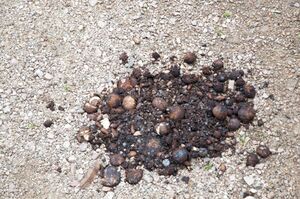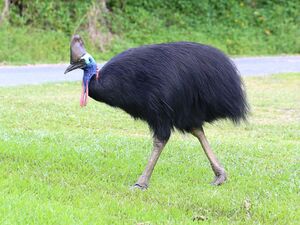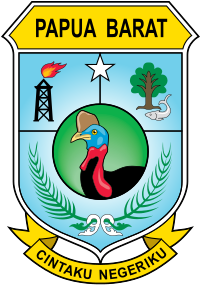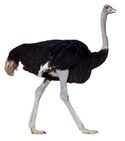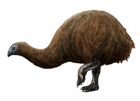قسورة (طائر)
| قسورة | |
|---|---|
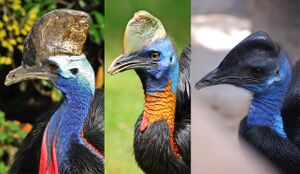
| |
| Montage of three species; left to right: southern cassowary, northern cassowary and dwarf cassowary | |
| التصنيف العلمي | |
| أصنوفة غير معروفة (أصلحها): | Casuarius |
| Type species | |
| Struthio casuarius[2] | |
| Species | |
| |
| Synonyms | |
Cassowaries (قالب:Lang-tpi, إندونيسية: kasuari) are flightless birds of the genus Casuarius in the order Casuariiformes. They are classified as ratites: flightless birds without a keel on their sternum bones. Cassowaries are native to the tropical forests of New Guinea (Papua New Guinea and West Papua), the Aru Islands (Maluku), and northeastern Australia.[4]
Three cassowary species are extant. The most common, the southern cassowary,[5] is the third-tallest and second-heaviest living bird, smaller only than the ostrich and emu. The other two species are represented by the northern cassowary and the dwarf cassowary; the northern cassowary is the most recently discovered and the most threatened.[5] A fourth but extinct species is represented by the pygmy cassowary.
Around 90% of the Cassowary diet consists of fruit, although all species are opportunistic omnivores, and take a range of other plant foods, including shoots and grass seeds, in addition to fungi, invertebrates, eggs, carrion, fish, and small vertebrates like rodents, small birds, frogs, lizards, and snakes.[6] Although all ratites can eat meat, Cassowaries, by definition, are the most omnivorous and, therefore, the largest omnivorous bird where meat still forms a minute part of their diet.[7] Indeed, whilst not hypercarnivorous predators like birds-of-prey, cassowaries including juveniles are not picky eaters and are willing to eat anything that will fit in their mouths.[8][9][10] They also have the most varied diet in protein consumption, in contrast to other ratites such as ostriches, where meat is largely used as a substitute in harsh times and is limited to mere invertebrates and small animals. Cassowaries are very wary of humans, but if provoked, they are capable of inflicting serious, even fatal, injuries upon both dogs and people. The cassowary has often been labelled "the world's most dangerous bird",[5][11] although in terms of recorded statistics, it pales in comparison to the common ostrich that is recorded to kill two to three humans per year in South Africa.[12]
. . . . . . . . . . . . . . . . . . . . . . . . . . . . . . . . . . . . . . . . . . . . . . . . . . . . . . . . . . . . . . . . . . . . . . . . . . . . . . . . . . . . . . . . . . . . . . . . . . . . . . . . . . . . . . . . . . . . . . . . . . . . . . . . . . . . . . . . . . . . . . . . . . . . . . . . . . . . . . . . . . . . . . . .
التصنيف والنظاميات والتطور
The genus Casuarius was erected by French scientist Mathurin Jacques Brisson in his Ornithologie published in 1760.[13] The type species is the southern cassowary (Casuarius casuarius).[14] The Swedish naturalist Carl Linnaeus had introduced the genus Casuarius in the sixth edition of his Systema Naturae published in 1748,[15] but Linnaeus dropped the genus in the important tenth edition of 1758 and put the southern cassowary together with the common ostrich and the greater rhea in the genus Struthio.[16][17] As the publication date of Linnaeus's sixth edition was before the 1758 starting point of the International Commission on Zoological Nomenclature, Brisson, and not Linnaeus, is considered the authority for the genus.[18]
Cassowaries (from ملايو: kasuari[19] cognate of several related languages spoken around the Moluccas and New Guinea[20]) are part of the ratite group, which also includes the emu, rheas, ostriches, and kiwi, as well as the extinct moas and elephant birds. These species are recognised:
| Image | Scientific name | Common name | Distribution |
|---|---|---|---|
 |
Casuarius casuarius | Southern cassowary or double-wattled cassowary | southern New Guinea, northeastern Australia, and the Aru Islands, mainly in lowlands[4] |
 |
Casuarius unappendiculatus | Northern cassowary or single-wattled cassowary | Northern and western New Guinea, and Yapen, mainly in lowlands[4][21] |
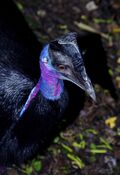 |
Casuarius bennetti | Dwarf cassowary or Bennett's cassowary | New Guinea, New Britain, and Yapen, mainly in highlands[4] |
| (Extinct) † | Casuarius lydekkeri | Pygmy cassowary or small cassowary | Pleistocene fossils of New South Wales[22] and Papua New Guinea[23] |
Most authorities consider the taxonomic classification above to be monotypic, but several subspecies of each have been described,[24] and some of them have even been suggested as separate species, e.g., C. (b) papuanus.[21] The taxonomic name C. (b) papuanus also may be in need of revision to Casuarius (bennetti) westermanni.[25] Validation of these subspecies has proven difficult due to individual variations, age-related variations, the scarcity of specimens, the stability of specimens (the bright skin of the head and neck—the basis of describing several subspecies—fades in specimens), and the practice of trading live cassowaries for thousands of years, some of which are likely to have escaped or been deliberately introduced to regions away from their origin.[21]
The evolutionary history of cassowaries, as of all ratites, is not well known. Genetic evidence suggests that their closest living relatives are emus, and that the dwarf cassowary is more closely related to the Northern Cassowary than either is to the Southern cassowary.[26] A fossil species was reported from Australia, but for reasons of biogeography, this assignment is not certain, and it might belong to the prehistoric Emuarius, which was a genus of cassowary-like primitive emus.
الوصف
Typically, all cassowaries are shy birds that are found in the deep forest. They are adept at disappearing long before a human knows they are there. The southern cassowary of the far north Queensland rain forests is not well studied, and the northern and dwarf cassowaries even less so. Females are larger and more brightly coloured than the males. Adult southern cassowaries are 1.5 to 1.8 m (4 ft 11 in to 5 ft 11 in) tall, although some females may reach 2 m (6 ft 6+1⁄2 in),[27] and weigh 58.5 kg (130 lb).[21] However, it is not uncommon to see exceptionally large females topping the scales beyond 70 kg (150 lb), with the largest maximum recorded being a southern cassowary at 85 kg (187 lb) and 190 cm (6 ft 3 in) tall.
Hence, by technicality, all three species of cassowaries are considered as Asia's largest bird since the extinction of the Arabian ostrich. Moreover, not only is the cassowary Asia's largest bird, within New Guinea, the cassowary is the island's second largest terrestrial animal after the introduction of Cervidaes such as the rusa deer, chital, and fallow deer.[28]
All cassowaries' feathers consist of a shaft and loose barbules. They do not have rectrices (tail feathers) or a preen gland. Cassowaries have small wings with five or six large remiges. These are reduced to stiff, keratinous quills, resembling porcupine quills, with no barbs.[21] The furcula and coracoid are degenerate, and their palatal bones and sphenoid bones touch each other.[29] These, along with their wedge-shaped body, are thought to be adaptations to ward off vines, thorns, and saw-edged leaves, allowing them to run quickly through the rainforest.[30]
Cassowaries have three-toed feet with sharp claws. The inner (first) toe has a dagger-like claw that may be 125 mm (5 in) long.[21] This claw is particularly fearsome, since cassowaries sometimes kick humans and other animals with their powerful legs. Cassowaries can run at up to 50 km/h (30 mph) through the dense forest and can jump up to 1.5 m (4 ft 11 in). They are good swimmers, crossing wide rivers and swimming in the sea.[31]
All three species have a keratinous, skin-covered casque on their heads that grows with age. The casque's shape and size, up to 18 cm (7 in), is species-dependent. C. casuarius has the largest and C. bennetti the smallest (tricorn shape), with C. unappendiculatus having variations in between. Contrary to earlier findings, the hollow inside of the casque is spanned with fine fibres.[26]
Several functions for the casque have been proposed. One is that they are a secondary sexual characteristic. Other suggested functions include batting through the underbrush, as a weapon in dominance disputes, or pushing aside leaf litter during foraging.[32] The latter three are disputed by biologist Andrew Mack, whose personal observation suggests that the casque amplifies deep sounds.[33] This is related to a discovery that at least the dwarf cassowary and southern cassowary produce very low-frequency sounds, which may aid in communication in dense rainforests.[33] The "boom" vocalization that cassowaries produce is the lowest-frequency bird call known and is at the lower limit of human hearing.[34] Recent study suggests that casque acts as a thermal radiator, offloading heat at high temperatures and restricting heat loss at low temperatures.[35]
The average lifespan of wild cassowaries is approximately 18-20 years, with those held in captivity living up to 40 years.[36]
السلوك والبيئة
Cassowaries are solitary birds except during courtship, egg-laying, and sometimes around ample food supplies.[29] The male cassowary defends a territory of about 7 km2 (1,700 acres) for himself. Female cassowary have larger territories, overlapping those of several males.[بحاجة لمصدر] While females move among satellite territories of different males, they appear to remain within the same territories for most of their lives, mating with the same, or closely related, males over the course of their lives.
Courtship and pair-bonding rituals begin with the vibratory sounds broadcast by females. Males approach and run with their necks parallel to the ground while making dramatic movements of their heads, which accentuate the frontal neck region. The female approaches drumming slowly. The male crouches on the ground, and the female either steps on the male's back for a moment before crouching beside him in preparation for copulation, or she may attack. This is often the case with the females pursuing the males in ritualistic chasing behaviours that generally terminate in water. The male cassowary dives into water and submerges himself up to his upper neck and head. The female pursues him into the water, where he eventually drives her to the shallows, where she crouches making ritualistic motions of her head. The two may remain in copulation for extended periods of time. In some cases, another male may approach and run off the first male. He will climb onto her to copulate, as well.[بحاجة لمصدر]
Males are far more tolerant of one another than females, which do not tolerate the presence of other females.[بحاجة لمصدر]
التكاثر
يأتي اللون الأخضر لبيض القسورة الجنوبي من البيليفيردين وهي صبغة توجد في العصارة الصفراوية و شائعة في قشر بيض الطيور، وهي الصبغة التي تظهر بعد تمزق الشعيرات الدموية الرقيقة بسبب الإصابة، مما يتيح للدم إمكانية التسرب إلى الأنسجة الداخلية المحيطة والمعروف بالكدمات أو الرضوض، يمكن للرضوض أن تشمل شعيرات دموية بمستوى الجلد أو نسيج تحت الجلد. بحسب قوة الصدمة ،عند الرض أو الكدمات يتحطم بروتين الهيموجلوبين من خلايا الدم الحمراء المتسربة في الحيز الخارجي للخلية.
فتظهر الألوان المميّزة للرضوض (كالاخضر والازرق والبني )نتيجة لـ البلعمة والتفسخ التسلسلي لبروتين الهيموجلوبين من ضمنها صبغة (بيليفيردين) وهي نفس الصبغة التي تسبب هالات تحت العينين باللون المُزرق او الاخضر ، لان طبقة الجلد رقيقة ولا يوجد طبقة من الدهون، لذا لا ينصح بفرك أو مسح تحت العينين بقوة أو وضع بعض مستحضرات التجميل الغير مخصصة للمنطقة تحت العينين.
نظرا لأن طيور القسورة تعشش على الأرض، فإن اللون الأخضر لبيضها يتماشى ويتموه مع لون ارضية الغابات الاستوائية لحماية البيض من الحيوانات المفترسة يتزامن موسم تكاثر طائر القسورة عندما تكون الفاكهة متوفرة تحديداً من يونيو إلى أكتوبر.
ستضع الأنثى من ثلاث إلى ست بيضات ثم تغادر. ليتحمل الذكر وحده مسؤولية تفريخ البيض وتربية الكتاكيت المخططة ذات اللون البني والقشدي.
وهي زوجة أخطر طائر في العالم تبيض ثم تهرب.[37]
The cassowary breeding season starts in May to June. Females lay three to eight large, bright green or pale green-blue eggs in each clutch into a heap of leaf litter prepared by the male.[29] The eggs measure about 9 by 14 cm (3.5 by 5.5 in) – only ostrich and emu eggs are larger.
The male incubates those eggs for 50–52 days, removing or adding litter to regulate the temperature, then protects the chicks, which stay in the nest for about 9 months. He defends them fiercely against all potential predators, including humans. The young males later go off to find a territory of their own.[29]
The female does not care for the eggs or the chicks, but rather moves on within her territory to lay eggs in the nests of several other males. Young cassowaries are brown and have buffy stripes. They are often kept as pets in native villages (in New Guinea), where they are permitted to roam like barnyard fowl until nearing maturity. Caged birds are regularly bereft of their fresh plumes.[30]
النظام الغذائي
Cassowaries are predominantly frugivorous, but omnivorous opportunistically when small prey is available. Besides fruits, their diet includes flowers, fungi, snails, insects, frogs, birds, fish, rats, mice, and carrion, although their hunting of small prey is more akin to foraging if they could catch them. Despite their similar omnivorous foraging behaviour, cassowaries and introduced wild boars had co-existed for thousands of years in New Guinea, even though it should have dictated that both species should be in direct competition such as in the case in the cassowary population in Queensland, Australia.
Fruit from at least 26 plant families has been documented in the diet of cassowaries. Fruits from the laurel, podocarp, palm, wild grape, nightshade, and myrtle families are important items in the diet.[29] The cassowary plum takes its name from the bird.
Where trees are dropping fruit, cassowaries come in and feed, with each bird defending a tree from others for a few days. They move on when the fruit is depleted. Fruit, even items as large as bananas and apples, is swallowed whole. Cassowaries are a keystone species of rain forests because they eat fallen fruit whole and distribute seeds across the jungle floor via excrement.[29]
In more urbanised areas, especially in Queensland, Australia, 'urbanised' Cassowaries have adopted to also feed on picnic blankets, tables and baskets or backyard bird feeders and compost heaps, thereby consuming a wide range of non-natural and non-native foods as well.[38]
. . . . . . . . . . . . . . . . . . . . . . . . . . . . . . . . . . . . . . . . . . . . . . . . . . . . . . . . . . . . . . . . . . . . . . . . . . . . . . . . . . . . . . . . . . . . . . . . . . . . . . . . . . . . . . . . . . . . . . . . . . . . . . . . . . . . . . . . . . . . . . . . . . . . . . . . . . . . . . . . . . . . . . . .
الدور في تشتت البذور وإنباتها
Cassowaries feed on the fruit of several hundred rainforest species and usually pass viable seeds in large, dense scats. They are known to disperse seeds over distances greater than a kilometre, thus playing an important role in the ecosystem. Germination rates for seeds of the rare Australian rainforest tree Ryparosa were found to be much higher after passing through a cassowary's gut (92% versus 4%).[39]
التهديدات
In its main home of New Guinea, cassowaries are the island's largest and most dominant and formidable bird. As such, adult cassowaries have no natural enemies other than humans (and even then, the birds are rarely hunted due to their reputation, with juveniles being preferred over adults for ceremonial purposes), but their chicks are vulnerable to large pythons, monitor lizards, New Guinea singing dogs, and Papuan eagles. Adult males aggressively defend their chicks. While adult males usually scare off most predators, a chick will occasionally be separated in the chaos and become a potential target.[40]
However, in the relic populations of north-eastern Australia, the cassowary population faces threats from vehicles, and are in danger of being outcompeted by wild boars, with their eggs being most vulnerable to boar predation.[41] Their chicks also face dangers and predation from domesticated dogs, which results in a widespread decline in the Australian mainland. It is unknown why the cassowary population in Australia is in decline, as the New Guinea population has dealt with introduced wild boars, dogs and feral cats for thousands of years longer with little to no impact on its population, suggesting that either the cassowaries of New Guinea had long adapted to human-introduced species or that the rich biodiversity of New Guinea allowed for additional niche partitioning.[42]
As for eating the cassowary, it is supposed to be quite tough. Australian administrative officers stationed in New Guinea were advised that it "should be cooked with a stone in the pot: when the stone is ready to eat, so is the cassowary".[43]
التوزيع والموائل
Cassowaries are native to the humid rainforests of New Guinea, nearby smaller islands, East Nusa Tenggara, the Maluku Islands, and northeastern Australia.[4] They do, however, venture out into palm scrub, grassland, savanna, and swamp forest. Whether some island populations are natural or the result of human trade in young birds is unclear.[29] They can also be easily spotted in some national parks such as Mellwraith Range National Park, Paluma Range National Park, and Jardine National Park in Australia.[44]
الوضع والحفظ
The southern cassowary is endangered in Queensland. Kofron and Chapman, when they assessed the decline of this species, found that of the former cassowary habitat, only 20–25% remains. Habitat loss and fragmentation is the primary cause of decline.[45] They then studied 140 cases of cassowary mortality, and found that motor-vehicle strikes accounted for 55% of the deaths, and dog attacks produced another 18%. Remaining causes of death included hunting (five cases), entanglement in wire (one case), the removal of cassowaries that attacked humans (four cases), and natural causes (18 cases), including tuberculosis (four cases). The cause for 14 cases was indicated as "for unknown reasons".[45]
Hand feeding cassowaries poses a significant threat to their survival because it lures them into suburban areas. There, the birds are more susceptible to encounters with vehicles and dogs.[46] Contact with humans encourages cassowaries to take food from picnic tables. Feral pigs also are a significant threat to their survival. They destroy nests and eggs of cassowaries, but their worst effect is as competitors for food, which may be catastrophic for the cassowaries during lean times.[47][48]
In February 2011, Cyclone Yasi destroyed a large area of cassowary habitat, endangering 200 of the birds–about 10% of the total Australian population.[49]
The Mission Beach community in far north Queensland holds an annual Cassowary Festival in September, where funds are raised to map the bird's habitat.[50]
في الأسر
The cassowary has solitary habits and breeds less frequently in zoos than other ratites such as ostrich and emu. Unlike other ratites, it lives exclusively in tropical rainforest, and reproducing this habitat carefully is essential. Unlike the emu, which will live with other sympatric species, such as kangaroos, in "mixed Australian fauna" displays, the cassowary does not cohabit well among its own kind. Individual specimens must even be kept in separate enclosures, due to their solitary and aggressive nature. Territoriality is one of their most important characteristics.
The double-wattled cassowary (C. casuarius) is the most popular species in captivity, and it is fairly common in European and American zoos, where it is known for its unmistakable appearance. اعتبارا من 2019[تحديث], only Weltvogelpark Walsrode in Germany has all three species of cassowaries in its collection: single-wattled cassowary (Casuarius unappendiculatus) and Bennett's cassowary (Casuarius bennetti). If subspecies are recognised, Weltvogelpark Walsrode has C. b. westermanni and C. u. rufotinctus.
العلاقة مع البشر
الدور في ثقافات بابوا وشبه التدجين

There is evidence that the cassowary may have been domesticated by humans thousands of years before the chicken. Some New Guinea Highlands societies capture cassowary chicks and raise them as semi-tame poultry, for use in ceremonial gift exchanges and as food.[51][52] They are the only indigenous Australasian animal known to have been partly domesticated by people prior to European arrival and colonization and by definition, the oldest form of domesticated animal and the largest domesticated bird.[53] The Maring people of Kundagai sacrificed cassowaries (C. bennetti) in certain rituals.[54] The Kalam people considered themselves related to cassowaries, and did not classify them as birds, but as kin.[52] Consequently, they use the Pandanus register of the Kalam language when eating cassowary meat.[55]
Studies on Pleistocene/early Holocene cassowary remains in Papua suggest that indigenous people at the time preferred to harvest eggs rather than adults. They seem to have regulated their consumption of these birds, possibly even collecting eggs and rearing young birds as one of the earliest forms of domestication.[56]
. . . . . . . . . . . . . . . . . . . . . . . . . . . . . . . . . . . . . . . . . . . . . . . . . . . . . . . . . . . . . . . . . . . . . . . . . . . . . . . . . . . . . . . . . . . . . . . . . . . . . . . . . . . . . . . . . . . . . . . . . . . . . . . . . . . . . . . . . . . . . . . . . . . . . . . . . . . . . . . . . . . . . . . .
Urbanisation of local cassowary population
In extremely urbanised areas where Cassowaries used to naturally live such as in Queensland, Australia or in Port Moresby, Papua New Guinea, the local Cassowary population had adapted to its less forested grounds. Increasing urbanisation has increased the likelihood of human-cassowary interaction, a potentially dangerous mix.[57] Although cassowary populations have faced challenges in these urban areas in Northeastern Australia and parts of New Guinea, the cassowaries have proven to be surprisingly quite adaptable in contrast to the Kiwis of New Zealand, making them the largest and most urbanised birds in the world.
It was found that cassowaries in these urban environments changed their diets accordingly, with urbanised cassowaries actually consuming an even greater proportion of fruits from exotic plants (~30%) but still incorporating a significant proportion of fruits from native plants in their diet.[58] Likewise, as aforementioned, the high concentration of human activity in the urban ecology also equates to a higher concentration of food diversity and food waste, with these 'urbanised' cassowaries foraging for food scraps, bird feeders and outdoor picnic/food venues without fear from humans or domesticated animals due to the birds' size and reputation.[38]
Due to their omnivorous nature, cassowaries are able to eat all types of human food, including processed ones if they feel like it, although fruit still remains their favourite choosings.[38][59] The high concentration of human activity as well as vehicles, mixed with domesticated animals and less forest coverage, had also changed their behaviours. These 'city' cassowaries were shown to exist in a higher state of activity and rested less than individuals inhabiting more intact swathes of rainforest, actively moving between urban gardens and the rainforest.[58] The study give evidence that these birds showed a surprising amount of flexible foraging strategy that has enabled them to persist in rainforest-fragmented landscapes.[58]
الهجمات
Cassowaries have a reputation for being dangerous to people and domestic animals. During World War II, American and Australian troops stationed in New Guinea were warned to steer clear of them. In his 1958 book Living Birds of the World, ornithologist Ernest Thomas Gilliard wrote:
The inner or second of the three toes is fitted with a long, straight, murderous nail which can sever an arm or eviscerate an abdomen with ease. There are many records of natives being killed by this bird.[60]
This assessment of the danger posed by cassowaries has been repeated in print by authors, including Gregory S. Paul[61] and Jared Diamond.[62] A 2003 historical study of 221 cassowary attacks showed that 150 had been against humans; 75% of these had been from cassowaries that had been fed by people, 71% of the time the bird had chased or charged the victim, and 15% of the time they kicked. Of the attacks, 73% involved the birds expecting or snatching food, 5% involved defending their natural food sources, 15% involved defending themselves, and 7% involved defending their chicks or eggs. Only one human death was reported among those 150 attacks.[63]
The first documented human death caused by a cassowary was on April 6, 1926. In Australia, 16-year-old Phillip McClean and his brother, age 13, came across a cassowary on their property and decided to try to kill it by striking it with clubs. The bird kicked the younger boy, who fell and ran away as his older brother struck the bird. The older McClean then tripped and fell to the ground. While he was on the ground, the cassowary kicked him in the neck, opening a 1.25-centimetre (0.49 in) wound that severed his jugular vein. The boy died of his injuries shortly thereafter.[64][65]
Cassowary strikes to the abdomen are among the rarest of all, but in one case in 1995, a dog was kicked in the belly. The blow left no puncture, but severe bruising occurred. The dog later died from an apparent intestinal rupture.[64]
Another human death due to a cassowary was recorded in Florida on April 12, 2019. The bird's owner, a 75-year-old man who had raised the animal, was apparently clawed to death after he fell to the ground.[11][66][67][68][69][70]
مرئيات
| هجوم من الكاسوراي على البشر. |
| هجوم من الكاسوراي على البشر. |
| طائر القسورة. |
| هجوم من الكاسوراي على البشر. |
| طائر القسورة. |
أنظر أيضاً
المصادر
الاستشهادات
- ^ Melville, R. V.; Smith, J. D. D., eds. (1987). Official Lists and Indexes of Names and Works in Zoology. ICZN. p. 17.
- ^ "Cassuaridae". aviansystematics.org. The Trust for Avian Systematics. Retrieved 2023-08-05.
- ^ "Part 7 - Vertebrates". Collection of group names. 2007. Archived from the original on 2016-10-05. Retrieved 2016-05-04.
- ^ أ ب ت ث ج خطأ: الوظيفة "harvard_core" غير موجودة..
- ^ أ ب ت "Cassowary". San Diego Zoo Wildlife Alliance. 2022. Retrieved 18 September 2022.
- ^ "What Do Cassowaries Eat? (Full Diet, Habits and Behavior)". Birdfact. 2022.
- ^ "What Do Cassowaries Eat?". AZ Animals. 2022.
- ^ "cassowaries eating dead bird". YouTube. 2021.
- ^ "Cassowary & babies eating roadkill". YouTube. 2018.
- ^ "Cassowary eating turtle". YouTube. 2023.
- ^ أ ب Mosbergen, Dominique (2019-04-14). "'World's Most Dangerous Bird' Kills 75-Year-Old Owner In Florida". HuffPost. Retrieved 2019-04-15.
- ^ Usurelu, Sergiu; Bettencourt, Vanessa; Melo, Gina (2015). "Abdominal trauma by ostrich". Annals of Medicine & Surgery. 4 (1): 41–43. doi:10.1016/j.amsu.2014.12.004. PMC 4323753.
- ^ Brisson, Mathurin Jacques (1760). Ornithologie, ou, Méthode contenant la division des oiseaux en ordres, sections, genres, especes & leurs variétés (in الفرنسية and اللاتينية). Vol. 1. Paris: Jean-Baptiste Bauche. Vol. 1, p. 46, Vol. 5: p. 10, Plate 1 fig 2.
- ^ Mayr, Ernst; Cottrell, G. William, eds. (1979). Check-list of Birds of the World. Vol. 1 (2nd ed.). Cambridge, Massachusetts: Museum of Comparative Zoology. p. 7.
- ^ Linnaeus, Carl (1748). Systema Naturae sistens regna tria naturæ, in classes et ordines, genera et species redacta tabulisque aeneis illustrata (in اللاتينية) (6th ed.). Stockholmiae (Stockholm): Godofr, Kiesewetteri. pp. 16, 27.
- ^ Linnaeus, Carl (1758). Systema Naturæ per regna tria naturae, secundum classes, ordines, genera, species, cum characteribus, differentiis, synonymis, locis (in اللاتينية). Vol. 1 (10th ed.). Holmiae (Stockholm): Laurentii Salvii. p. 155.
- ^ Allen, J.A. (1910). "Collation of Brisson's genera of birds with those of Linnaeus". Bulletin of the American Museum of Natural History. 28: 317–335. hdl:2246/678.
- ^ "Article 3". International Code of Zoological Nomenclature (4th ed.). London: International Trust for Zoological Nomenclature. 1999. ISBN 978-0-85301-006-7.
- ^ "cassowary". Oxford English Dictionary (Online ed.). Oxford University Press. قالب:OEDsub
- ^ Mahdi, Waruno (2007). Malay Words and Malay Things: Lexical Souvenirs from an Exotic Archipelago in German Publications Before 1700. Otto Harrassowitz Verlag. pp. 192–3. ISBN 978-3-447-05492-8.
Cognates occur in [...] Alune kafwali, Amahai asuwaro, Elpaputih asawari, Manusela asuwalia, Masiwang asawais, Ambelau kaswari, Kayeli kasawari, Nusalaut asuwalyo, Saparua asawallo, Haruku kasawari...Kowiai asawar, Onin kasawari, Biak manswar, Dusner masuar, Windesi maswa, Sobei swodi, Tarfia kasur, Yotafa hetuwar...
{{cite book}}: Check|author-link=value (help) - ^ أ ب ت ث ج ح خطأ: الوظيفة "harvard_core" غير موجودة..
- ^ Miller, Alden H. (June 19, 1962). "The history and significance of the fossil Casuarius lydekkeri" (PDF). Records of the Australian Museum. The Australian Museum. 25 (10): 235–238. doi:10.3853/j.0067-1975.25.1962.662. Retrieved March 20, 2017.
- ^ Rich, P. V.; Plane, Michael; Schroeder, Natalie (1988). "A pygmy cassowary (Casuarius lydekkeri) from late Pleistocene bog deposits at Pureni, Papua New Guinea" (PDF). BMR Journal of Australian Geology & Geophysics. 10: 377–389.
- ^ "The Taxonomy of the Genus Cassowarius". perron.eu. Archived from the original on 2016-03-05. Retrieved July 7, 2017.
- ^ Perron (2011), pp. 54–8.
- ^ أ ب Naish, D.; Perron, R. (2016). "Structure and function of the cassowary's casque and its implications for cassowary history, biology and evolution". Historical Biology. 28 (4): 507–518. doi:10.1080/08912963.2014.985669. S2CID 84497795.
- ^ "The Cassowary Bird". Buzzle.com. Archived from the original on March 15, 2009. Retrieved 2016-09-20.
- ^ Ziegler, A.C. (1982). Biogeography and ecology of New Guinea. The Hague: Junk.
- ^ أ ب ت ث ج ح خ خطأ: الوظيفة "harvard_core" غير موجودة.
- ^ أ ب خطأ: الوظيفة "harvard_core" غير موجودة..
- ^ خطأ: الوظيفة "harvard_core" غير موجودة..
- ^ Crome, F.; Moore, L (1988). "The cassowary's casque". Emu. 88 (2): 123–124. doi:10.1071/MU9880123.
- ^ أ ب Mack & Jones (2003).
- ^ Owen (2003).
- ^ Eastick, Danielle L., et al. "Cassowary casques act as thermal windows." Scientific reports 9.1 (2019): 1966.
- ^ "Southern cassowary". Smithsonian's National Zoo (in الإنجليزية). 2023-03-23. Retrieved 2023-07-13.
- ^ "البيض الأخضر". 2024-03-28
publisher =𝑻𝑨𝑲𝑻𝑶. Retrieved 2024-04-02.
{{cite web}}: Check date values in:|date=(help); Missing pipe in:|date=(help); line feed character in|date=at position 11 (help) - ^ أ ب ت Dennis, Andrew J. (2023). "National Recovery Plan for the Southern Cassowary Casuarius casuarius johnsonii" (PDF). Canberra: Department of Climate Change, Energy, the Environment and Water. p. 19. Archived from the original (PDF) on July 3, 2023. Retrieved July 3, 2023.
- ^ Webber & Woodrow (2004).
- ^ Roots, Clive. Flightless birds. Greenwood Publishing Group, 2006.
- ^ "Giant Cassowaries are Modern-day Dinosaurs". YouTube. 2019.
- ^ Bulmer, S. (1982). Biogeography and ecology of New Guinea. The Hague: Junk.
- ^ Vader, John, New Guinea: The Tide is Stemmed. NY, Ballantine Books: 1971, p. 35.
- ^ "Cassowary: Description, Pictures, & Fun Facts I TheBirdPedia" (in الإنجليزية الأمريكية). 2021-12-09. Retrieved 2022-02-17.
- ^ أ ب Kofron & Chapman (2006).
- ^ Borrell (2008).
- ^ Sexton-Mcgrath, Kristy; Stephen, Adam (2018-05-30). "Feral pigs decimating cassowaries in world heritage-listed Daintree, filmmaker says". ABC News (in الإنجليزية الأسترالية). Retrieved 2021-01-28.
- ^ International), BirdLife International (BirdLife) (2018-08-09). "IUCN Red List of Threatened Species: Casuarius casuarius". IUCN Red List of Threatened Species. Retrieved 2021-01-28.
- ^ "Cyclone puts cassowary in greater peril". The Independent. February 27, 2011.
- ^ "Cassowary carnival: Queensland town celebrates a famous flightless bird". SBS Language (in الإنجليزية). Retrieved 2022-11-10.
- ^ Katie Hunt. "World's most dangerous bird raised by humans 18,000 years ago, study suggests". CNN. Retrieved 2021-09-28.
- ^ أ ب Bulmer (1967).
- ^ Bourke, R. Michael: History of agriculture in Papua New Guinea in Food and Agriculture in Papua New Guinea, ANU Press, 2009
- ^ Healey, Chris (1991). "Why is the Cassowary sacrificed". Man and a Half: Essays in Pacific Anthropology and Ethnobiology in Honour of Ralph Bulmer (PDF). pp. 234–241. Archived from the original (PDF) on September 28, 2020. Retrieved July 30, 2020.
- ^ Majnep, Ian Saem; Bulmer, Ralph (1977). Birds of my Kalam Country [Mn̄mon Yad Kalam Yakt] (in English). illustrations by Christopher Healey. New Zealand: Auckland University Press. pp. 150, 152. ISBN 9780196479538. OCLC 251862814.
{{cite book}}: CS1 maint: unrecognized language (link) - ^ Douglass, Kristina; Gaffney, Dylan; Feo, Teresa J.; Bulathsinhala, Priyangi; Mack, Andrew L.; Spitzer, Megan; Summerhayes, Glenn R. (5 October 2021). "Late Pleistocene/Early Holocene sites in the montane forests of New Guinea yield early record of cassowary hunting and egg harvesting". Proceedings of the National Academy of Sciences. 118 (40): e2100117118. Bibcode:2021PNAS..11800117D. doi:10.1073/pnas.2100117118. PMC 8501781. PMID 34580213. S2CID 238203829.
- ^ Latch, Peter (2007). "Recovery plan for the southern cassowary Casuarius casuarius johnsonii" (PDF). Canberra: Department of the Environment, Water, Heritage and the Arts. p. 23-24.
- ^ أ ب ت Campbell, Mariana A.; Lawton, Tom; Udyawer, Vinay; Bell-Anderson, Kim S.; Westcott, David; Campbell, Hamish A. (2023). "The southern cassowary (Casuarius casuarius johnsonii) remains an important disperser of native plants in fragmented rainforest landscapes". Austral Ecology. Australia. 48 (4): 787–802. doi:10.1111/aec.13309.
- ^ "Cassowary bird tries to steal a woman's lunch". YouTube. 2023.
- ^ Gilliard (1958), p. 27.
- ^ Paul (1988), p. 364, 464.
- ^ Diamond (1997), p. 165.
- ^ Kofron (1999).
- ^ أ ب Kofron (2003).
- ^ Sather, Patrick (October 13, 2021). "10 Birds That Can't Fly". AZ Animals.
- ^ "Authorities: Large, flightless bird kills its Florida owner". ABC News. Alachua, Florida, USA. Associated Press. April 13, 2019. Retrieved 2019-04-13.
- ^ "Cassowary kills man at farm near Alachua". The Gainesville Sun. Alachua, Florida, USA. April 13, 2019. Retrieved 2019-04-13.
- ^ Hackney, Deanna; McLaughlin, Eliott C. (2019-04-15). "Cassowary, called 'most dangerous bird', attacks and kills Florida man". AP News. Retrieved 2019-04-16.
- ^ "Cassowary, world's 'most dangerous bird', kills owner in Florida". The Telegraph. 2019-04-14. ISSN 0307-1235. Archived from the original on January 12, 2022. Retrieved 2019-04-16.
- ^ Wenzlow, N.; Hamilton, W. F. (2021-02-18). "Cassowary Fatally Attacks Its Owner". Abstracts of the American Academy of Forensic Sciences Meeting. Houston, Texas: 590 (H 65).
Normally ... he would hold a 'shock stick' and had a second person with him. On that day ... he was alone and had entered the pen to retrieve one of the female's eggs. During the attack, the victim had fallen to the ground and the attack continued for an unknown period of time. The owner was able to call for help and his outcries alerted his wife, who entered the enclosure with a 'stun gun' to repel the female cassowary. By the time the victim was pulled to safety, he had sustained numerous injuries and had lost a substantial amount of blood. He was rushed to the hospital. ... The patient did not survive his injuries.
النصوص المستشهد بها
- Borrell, Brendan (October 2008). "Invasion of the Cassowaries". Smithsonian Magazine. Archived from the original on 2012-12-13.
- Brands, Sheila (August 14, 2008). "Systema Naturae 2000 / Classification – Genus Casuarius". sn2000.taxonomy.nl. The Taxonomicon. Archived from the original on October 5, 2016. Retrieved 2016-09-21.
- Bulmer, Ralph (March 1967). "Why is the Cassowary Not a Bird? A Problem of Zoological Taxonomy Among the Karam of the New Guinea Highlands". Man. 2 (1): 5–25. doi:10.2307/2798651. ISSN 0025-1496. JSTOR 2798651.
- Clark, Philip (November 5, 1990). "Stay in Touch". The Sydney Morning Herald. Cites "authorities" for the death claim.
- Clements, James (2007). The Clements Checklist of the Birds of the World (6 ed.). Ithaca, NY: Cornell University Press. ISBN 978-0-8014-4501-9.
- Crome, F.; Moore, L. (1988). "The cassowary's casque" (PDF). Emu. 88 (2): 123–124. doi:10.1071/MU9880123.
- Davies, Stephen J.J.F. (2002). Ratites and Tinamous. Oxford University Press. ISBN 0-19-854996-2.
- Davies, Stephen J.J.F. (2003). "Birds I: Tinamous and Ratites to Hoatzins". In Hutchins, Michael (ed.). Grzimek's Animal Life Encyclopedia. Vol. 8 (2nd ed.). Farmington Hills MI: Gale Group. ISBN 0-7876-5784-0.
- Diamond, Jared M. (March 1997). Guns, Germs, and Steel: The Fates of Human Societies. W.W. Norton & Co. ISBN 0-393-03891-2.
- Gilliard, E. Thomas (1958) [1958]. "Cassowaries". Living Birds of the World. New York City: Doubleday.
- Gotch, A. F. (1995) [1979]. "Cassowaries". Latin Names Explained. A Guide to the Scientific Classifications of Reptiles, Birds & Mammals. New York, NY: Facts on File. pp. 178–179. ISBN 0-8160-3377-3.
- Harmer, S.F.; Shipley, A.F. (1899). The Cambridge Natural History. Macmillan.
- Kofron, Christopher P. (December 1999). "Attacks to humans and domestic animals by the southern cassowary (Casuarius casuarius johnsonii) in Queensland, Australia". Journal of Zoology. 249 (4): 375–81. doi:10.1111/j.1469-7998.1999.tb01206.x.
- Kofron, Christopher P. (2003). "Case histories of attacks by the southern cassowary in Queensland". Memoirs of the Queensland Museum. 49 (1): 335–8.
- Kofron, Christopher P.; Chapman, Angela (2006). "Causes of mortality to the endangered Southern Cassowary Casuarius casuarius johnsonii in Queensland, Australia". Pacific Conservation Biology. 12 (3): 175–9. doi:10.1071/PC060175. Archived from the original on November 16, 2017. Retrieved January 6, 2015.
- Mack, Andrew L.; Jones, Josh (1 October 2003). "Low-frequency vocalizations by cassowaries (Casuarius spp.)". The Auk. 120 (4): 1062–8. doi:10.1642/0004-8038(2003)120[1062:LVBCCS]2.0.CO;2. S2CID 86025843.
- Naish, Darren; Perron, Richard M. (2014). "Structure and function of the cassowary's casque and its implications for cassowary history, biology and evolution". Historical Biology. 28 (4): 507–518. doi:10.1080/08912963.2014.985669. S2CID 84497795.
- Owen, J. (2003). "Does Rain Forest Bird "Boom" Like a Dinosaur?". National Geographic News.
- Paul, Gregory S. (1988). Predatory Dinosaurs of the World. New York City: Simon and Schuster. ISBN 9780671619466.
- Perron, Richard M. (2011). "The taxonomic status of Casuarius bennetti papuanus and C. b. westermanni" (PDF). Bull. B.O.C. 131 (1). Archived from the original (PDF) on 2015-11-22. Retrieved 2015-11-21.
- Perron, Richard M. (2016). Taxonomy of the Genus Casuarius. Quantum Conservation. ISBN 978-3-86523-272-4.
- Sclater, P. L. (October 14, 1875). "Cassowaries". Nature. 12 (311): 516–7. Bibcode:1875Natur..12..516S. doi:10.1038/012516a0.
- Underhill, D. (1993). Australia's Dangerous Creatures Reader's Digest. Sydney. ISBN 0-86438-018-6.
{{cite book}}: CS1 maint: location missing publisher (link) - Webber, Bruce L.; Woodrow, Ian E. (2 June 2004). "Cassowary frugivory, seed defleshing and fruit fly infestation influence the transition from seed to seedling in the rare Australian rainforest tree, Ryparosa sp. nov. 1 (Achariaceae)". Functional Plant Biology. 31 (5): 505–16. doi:10.1071/FP03214. PMID 32688922.
Further wording
- Rothschild, Walter (1899). A Monograph of the Genus Casuarius. Transactions of the Zoological Society of London, vol. 15, pt. 5, December 1900.
وصلات خارجية
- "C4 Community for Coastal and Cassowary Conservation". Retrieved 2023-04-19.
- Cassowary and chicks drinking water on Vimeo
- Cassowary videos, photos and sounds on the Internet Bird Collectionقالب:Dead url
 "Cassowary". Encyclopedia Americana. 1920.
"Cassowary". Encyclopedia Americana. 1920.- "Raising the World's Deadliest Bird". BirdNote. 2023-03-17. Retrieved 2023-04-19.
- "Southern cassowary - Casuarius casuarius". ARKive. 2004-08-05. Archived from the original on 2006-05-03. Retrieved 2023-04-19.
- CS1 الفرنسية-language sources (fr)
- CS1 اللاتينية-language sources (la)
- CS1 errors: invisible characters
- CS1 errors: missing pipe
- CS1 الإنجليزية الأمريكية-language sources (en-us)
- CS1 الإنجليزية الأسترالية-language sources (en-au)
- Short description is different from Wikidata
- Automatic taxobox cleanup
- Articles containing إندونيسية-language text
- Pages using Lang-xx templates
- Articles containing فرنسية-language text
- Articles containing لاتينية-language text
- Articles containing ملايو (لغة كبرى)-language text
- مقالات ذات عبارات بحاجة لمصادر
- Articles with unsourced statements from March 2019
- مقالات فيها عبارات متقادمة منذ 2019
- جميع المقالات التي فيها عبارات متقادمة
- CS1: Julian–Gregorian uncertainty
- CS1 maint: location missing publisher
- Casuariidae
- Birds of New Guinea
- Extant Zanclean first appearances
- Flightless birds
- Higher-level bird taxa restricted to the Australasia-Pacific region
